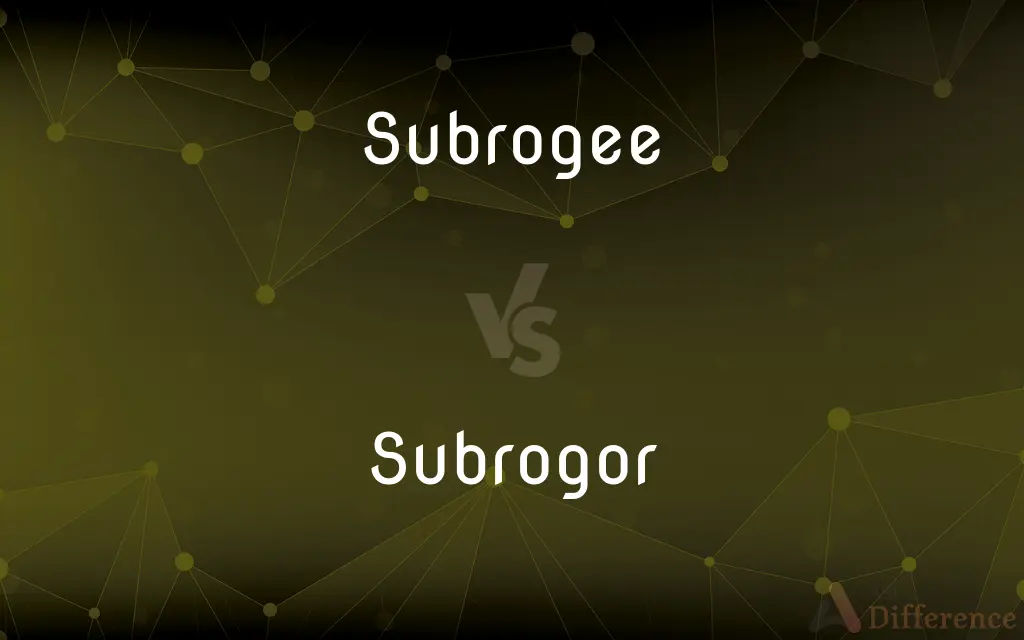Subrogee vs. Subrogor — What's the Difference?
By Tayyaba Rehman & Urooj Arif — Updated on March 22, 2024
Subrogee is entitled to compensation from a third party for a loss, while a subrogor transfers this right.

Difference Between Subrogee and Subrogor
Table of Contents
ADVERTISEMENT
Key Differences
Subrogee and subrogor are terms primarily used in the insurance and legal fields, particularly in the context of subrogation. Subrogation is a process where one party (subrogee) steps into the shoes of another (subrogor) to claim compensation from a third party responsible for a loss. The subrogee is often an insurance company that has paid for the loss and seeks to recover the amount from the party at fault. On the other hand, the subrogor is the insured party who originally suffered the loss and had the right to claim compensation but has transferred this right to the subrogee.
Subrogees, by assuming the rights of subrogors, actively pursue recovery from the responsible third parties. This process not only allows subrogees to recoup losses but also indirectly benefits subrogors by not having to engage in the recovery process themselves. Whereas subrogors, having transferred their claim rights to subrogees, are effectively relieved from the burden of pursuing compensation, which can be both time-consuming and costly.
The relationship between subrogees and subrogors is established through the principle of indemnity, which aims to prevent the insured from profiting from the insurance coverage. Subrogees step in to ensure that the principle of indemnity is upheld by seeking reimbursement only up to the amount of the loss covered. Meanwhile, subrogors are protected from the risk of double recovery, which would violate the principle of indemnity, by having transferred their rights to pursue further compensation.
The process of subrogation highlights the proactive role of subrogees in the legal pursuit against third parties at fault. It emphasizes the subrogee's legal and financial responsibilities in recovering the amounts paid out. In contrast, subrogors, having been indemnified by their insurance policy, play a passive role during the subrogation process, having already been compensated for their loss.
The interaction between subrogees and subrogors underscores a mutual benefit: subrogees recover the amounts paid out, and subrogors are spared the complexity of legal actions. This symbiotic relationship ensures the efficiency and effectiveness of the indemnification process, where the financial burden of losses is ultimately borne by those responsible for causing them.
ADVERTISEMENT
Comparison Chart
Definition
An entity (often an insurer) that steps into the shoes of another to seek reimbursement from a third party responsible for a loss.
The original party suffering a loss who transfers their right to seek compensation to another party.
Role in Subrogation
Pursues recovery from the responsible third party.
Transfers their right to claim compensation to the subrogee.
Benefit
Recovers the amount paid for the loss.
Is relieved from the burden of pursuing compensation.
Legal Position
Assumes the legal rights of the subrogor.
Has a passive role in the recovery process after transferring rights.
Purpose
Ensures the principle of indemnity is upheld by seeking reimbursement.
Protected from the risk of double recovery and the complexity of legal actions.
Compare with Definitions
Subrogee
An entity that assumes the right to pursue reimbursement from a third party responsible for a loss.
The insurance company became the subrogee after paying for the damages to the insured's car.
Subrogor
The original party who suffers a loss and has the right to seek compensation.
The homeowner, as a subrogor, transferred the claim rights to their insurance company.
Subrogee
Benefits from the subrogation process by recovering paid-out claims.
The subrogee successfully recouped the loss, minimizing financial impact.
Subrogor
Transfers the claim rights to the subrogee, typically an insurer.
After receiving the claim amount, the subrogor allowed the insurance company to pursue further recovery.
Subrogee
Often an insurance company that steps in to recover the amounts it has paid out to the insured.
As a subrogee, the insurer sought compensation from the negligent driver.
Subrogor
Relieved from the complexities of pursuing compensation after indemnification.
The subrogor appreciated being spared from the legal hassle post-claim.
Subrogee
Engages in the subrogation process to ensure that losses are recouped.
The subrogee initiated legal proceedings to recover the costs from the party at fault.
Subrogor
Plays a passive role in the subrogation process after indemnification.
Once compensated, the subrogor had no direct involvement in the subsequent recovery efforts.
Subrogee
Assumes the legal and financial responsibilities in the recovery process.
The subrogee worked diligently to uphold the principle of indemnity.
Subrogor
Protected from the risk of double recovery by transferring claim rights.
The subrogor's transfer of rights ensured adherence to the principle of indemnity.
Subrogee
(legal) The party acting on behalf of the subrogor in a subrogation.
Subrogor
(legal) The party on whose behalf another party (the subrogee) acts in a subrogation.
Common Curiosities
How does subrogation benefit a subrogee?
Subrogation allows a subrogee to recover the amounts paid out to the insured, minimizing their financial loss.
Can a subrogor claim compensation after transferring rights?
Once rights are transferred, the subrogor cannot claim additional compensation from the third party for the same loss.
What is a subrogee?
A subrogee is an entity, often an insurance company, that steps into the rights of another (the subrogor) to seek reimbursement from a third party responsible for a loss.
What does a subrogor do?
A subrogor is the original party suffering a loss who transfers their right to claim compensation to another entity, such as an insurance company.
What happens if a subrogee recovers more than the loss amount?
Any excess recovery beyond the covered loss amount is usually returned to the subrogor, depending on the terms of the insurance policy.
Why would a subrogor transfer their rights?
A subrogor transfers their rights to avoid the complexities and costs of pursuing compensation, relying on the expertise and resources of the subrogee.
What is the principle of indemnity?
The principle of indemnity prevents the insured from profiting from their loss, ensuring compensation only up to the amount of the actual loss.
Can a subrogee pursue any amount from the third party?
A subrogee can only pursue reimbursement up to the amount of the loss covered, adhering to the principle of indemnity.
Do all insurance claims involve subrogation?
Not all claims involve subrogation; it primarily applies when a third party is responsible for the insured's loss.
What are the key differences between a subrogee and a subrogor?
The key differences include their roles in the subrogation process, with the subrogee pursuing recovery and the subrogor transferring their right to compensation.
Is the subrogor involved in the recovery process?
After transferring their rights, the subrogor typically has a passive role and is not involved in the legal recovery process.
Share Your Discovery

Previous Comparison
Apprehension vs. Apprehensiveness
Next Comparison
Fatigue vs. MalaiseAuthor Spotlight
Written by
Tayyaba RehmanTayyaba Rehman is a distinguished writer, currently serving as a primary contributor to askdifference.com. As a researcher in semantics and etymology, Tayyaba's passion for the complexity of languages and their distinctions has found a perfect home on the platform. Tayyaba delves into the intricacies of language, distinguishing between commonly confused words and phrases, thereby providing clarity for readers worldwide.
Co-written by
Urooj ArifUrooj is a skilled content writer at Ask Difference, known for her exceptional ability to simplify complex topics into engaging and informative content. With a passion for research and a flair for clear, concise writing, she consistently delivers articles that resonate with our diverse audience.














































